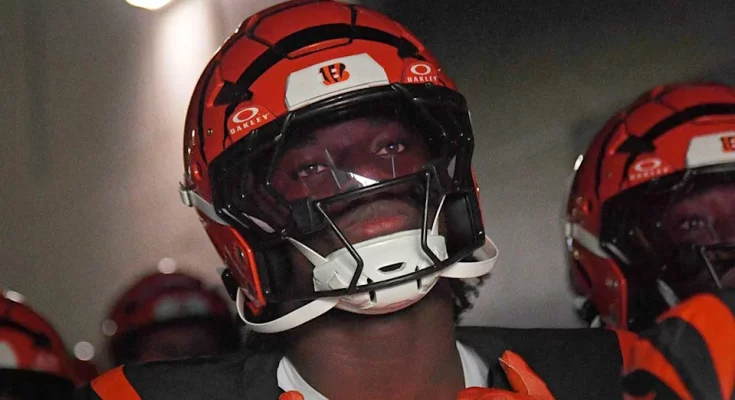The Cincinnati Bengals have found themselves navigating a tense moment in training camp after defensive standout Shemar Stewart received an official warning for an incident involving quarterback Joe Burrow. The altercation, which occurred during a high-intensity practice session, saw Stewart shove Burrow following a physical play, igniting discussions across the NFL community about player conduct, team dynamics, and the high-stakes environment of professional football practices. While the incident did not result in any disciplinary suspension, the Bengals organization has made it clear that such actions are taken seriously, emphasizing the importance of protecting their franchise quarterback and maintaining a professional, disciplined locker room culture.
Training camps in the NFL are notoriously high-pressure environments, with players pushed to their physical and mental limits as they prepare for the upcoming season. For the Bengals, this year’s camp has been particularly scrutinized, given their aspirations to contend in a highly competitive AFC North and the league at large. Joe Burrow, entering the next phase of his career after demonstrating remarkable poise and skill over the past few seasons, remains the focal point of the team’s offense. Protecting him is a non-negotiable priority for the coaching staff, and any incident that jeopardizes his safety, even during practice, is treated with utmost seriousness.
Shemar Stewart, a defensive talent who has shown flashes of potential as a disruptive force on the field, found himself at the center of attention after the shove. While practice intensity often involves close contact, physical clashes, and moments of frustration, shoving a quarterback crosses a line that teams rarely tolerate. The Bengals’ decision to issue a formal warning, rather than escalate to suspension or fines, reflects a balance between acknowledging the competitive nature of Stewart’s position and reinforcing the boundaries that protect the team’s leaders. Coaches have reportedly used the situation as a teaching moment, emphasizing accountability and the repercussions of letting emotions override professionalism during practice sessions.
Observers across the league have taken note of the incident, highlighting the broader context of NFL practices where emotions can run high. Defensive players, in particular, operate under immense pressure to make plays, sack the quarterback, and assert dominance on the field, which can sometimes spill over into overly aggressive behavior. The distinction between legitimate physicality and unacceptable conduct is razor-thin, and incidents like Stewart’s shove underscore the challenge coaches face in fostering a competitive yet controlled environment. Analysts have debated whether such moments are indicative of youthful inexperience, a lack of discipline, or simply an unavoidable aspect of intense preparation for the season.
From a team chemistry standpoint, the Bengals appear to be handling the situation with a mix of firmness and support. Joe Burrow, known for his leadership and composure, reportedly addressed the incident internally, emphasizing the importance of maintaining focus and not letting isolated events disrupt the overall rhythm of the team. Leadership within the locker room, particularly from veteran players, plays a critical role in diffusing tension and reinforcing professional standards. In this case, the incident has opened up dialogue among teammates about respecting boundaries while still pushing each other to achieve peak performance.
The warning issued to Stewart also carries a symbolic weight, sending a message to the entire roster about accountability. NFL teams routinely use formal warnings, fines, and suspensions not only as punitive measures but as preventative strategies. By making it clear that shoving a quarterback is unacceptable, the Bengals are signaling that the safety and well-being of their key players are paramount, and that every member of the team is expected to adhere to behavioral standards, even in the heat of competition. Such measures are especially significant in training camp settings, where habits formed during practice often carry over into the season and influence in-game behavior.
Media coverage of the incident has ranged from analytical breakdowns of practice footage to opinion pieces evaluating Stewart’s temperament and potential impact on the team. Some commentators have noted that moments like these, while newsworthy, are not uncommon in the NFL, where the intensity of practices frequently leads to heated interactions. Others have speculated on how the warning might affect Stewart’s standing within the team, particularly in the eyes of the coaching staff and veteran players who serve as role models for professionalism and discipline. While the long-term implications for Stewart remain uncertain, the immediate response from the organization demonstrates a commitment to maintaining order and respect within the squad.
In addition to team-level considerations, the incident has prompted discussions about player safety protocols in the NFL. Quarterbacks, due to the nature of their role, are especially vulnerable to physical contact, and teams invest significant resources in protective schemes and practice regulations to minimize risk. The shove incident involving Stewart highlights the ongoing need for vigilance, coaching oversight, and clear enforcement of rules designed to protect high-value players. League officials and team coaches alike recognize that maintaining a safe training environment is essential not only for individual players’ health but for the overall competitiveness and reputation of the team.
The Bengals’ approach to managing the aftermath of the incident also underscores the importance of communication and transparency. By publicly acknowledging the warning, the organization demonstrates accountability and reassures fans, stakeholders, and the media that player conduct is being monitored and managed appropriately. At the same time, internal measures, such as team meetings and discussions between coaches and players, aim to reinforce lessons learned without creating unnecessary tension or resentment. Such strategies are critical for sustaining a positive team culture, particularly in organizations with championship aspirations.
For Shemar Stewart, the incident represents a moment of growth and learning. Young players in the NFL often face challenges in managing their intensity and channeling aggression productively. While the shove was a misstep, the formal warning serves as a concrete reference point for the expectations of professional conduct moving forward. Coaches and mentors are likely working closely with Stewart to ensure that future interactions on the practice field prioritize skill, technique, and discipline over emotional reactions. If handled correctly, this experience could strengthen Stewart’s understanding of accountability and enhance his value as a team player capable of contributing without crossing boundaries.
Joe Burrow’s response to the incident also highlights the qualities that have made him a respected leader in the league. By maintaining composure, addressing the matter constructively, and focusing on team goals, Burrow sets a standard for professionalism and resilience. His approach sends a clear message to teammates that while competition is fierce, respect and discipline are non-negotiable elements of success. This balance between intensity and control is a hallmark of elite quarterbacks, and it serves as a stabilizing influence within the Bengals’ locker room.
The broader implications of the incident extend beyond the Bengals organization, reflecting trends in how NFL teams manage player conduct during training camp. Across the league, incidents involving aggressive interactions are not uncommon, but the manner in which they are addressed can significantly impact team morale, public perception, and player development. By issuing a warning rather than a harsher punishment, the Bengals strike a balance between enforcing rules and allowing for corrective growth. This approach illustrates a broader philosophy in professional sports: mistakes are opportunities for education and reinforcement of standards, rather than simply punitive events.
As the Bengals continue their preparation for the 2025 season, the team’s response to the Stewart-Burrow incident will be closely monitored. Coaches are likely to use the episode as a case study in professionalism, communication, and maintaining composure under pressure. Players are reminded that every action, even in practice, has consequences and that accountability is central to sustaining a cohesive, high-performing team. The warning issued to Stewart is more than a disciplinary measure—it is a teaching moment that reinforces the values of respect, discipline, and focus that underpin the Bengals’ approach to competition.
Fans, analysts, and league observers will undoubtedly continue to debate the incident, weighing the intensity of NFL practices against the need for player safety and professional conduct. While moments of tension and physicality are intrinsic to football, the handling of such situations is a testament to the organizational culture and leadership within the team. For the Bengals, the incident provides an opportunity to demonstrate their commitment to player welfare, set clear expectations for conduct, and reinforce the leadership principles that have contributed to their recent successes.
In conclusion, Shemar Stewart’s shove of Joe Burrow and the resulting warning offer a lens into the complex dynamics of NFL training camps, where intensity, skill development, and player interactions converge. The Bengals’ measured response underscores the importance of accountability, professional conduct, and team culture, while providing a constructive learning experience for Stewart and reinforcing Joe Burrow’s role as a leader. As the season approaches, the lessons from this incident are likely to resonate within the locker room, shaping behavior, guiding coaching strategies, and contributing to the Bengals’ pursuit of excellence on and off the field. It serves as a reminder that in professional sports, moments of tension can become defining opportunities for growth, discipline, and the reinforcement of values that ultimately drive team success.
The NFL landscape is unforgiving, and incidents like these, while isolated, carry lessons that extend beyond a single practice. The Bengals’ proactive handling of the situation demonstrates a forward-looking approach, one that prioritizes safety, accountability, and development, ensuring that competitive intensity is channeled productively rather than destructively. Stewart’s experience, Burrow’s leadership, and the organization’s response collectively reflect the ongoing challenge of balancing passion, professionalism, and protection in one of the most physically demanding sports in the world. As fans watch the Bengals’ journey through training camp and into the regular season, the episode serves as a case study in managing conflict, fostering growth, and maintaining focus on the ultimate goal: building a championship-caliber team.
The repercussions of this incident will likely resonate throughout the season, shaping interactions, practice intensity, and the way younger players approach competition. It also underscores a broader principle in professional football: talent and intensity must always be tempered with discipline and respect, particularly when it involves safeguarding key players like a franchise quarterback. The Bengals’ approach offers a blueprint for other organizations grappling with similar challenges, demonstrating that accountability, education, and measured disciplinary action can coexist to maintain both high standards and a competitive edge.
Ultimately, the Stewart-Burrow incident is a microcosm of the pressures, challenges, and learning moments that define NFL training camps. It illustrates the balance teams must strike between fostering competitiveness and enforcing professional conduct, highlighting the critical role of leadership, communication, and organizational values in navigating high-stakes situations. For Stewart, it is an opportunity to grow as a player and teammate; for Burrow, it reinforces his status as a resilient leader; and for the Bengals, it exemplifies a disciplined, proactive approach to team management that prioritizes both performance and player safety. As the season unfolds, the lessons from this episode will continue to influence the Bengals’ approach, shaping the culture, cohesion, and success of a team with championship aspirations.
The NFL, with its combination of talent, intensity, and relentless competition, inevitably produces moments like the Stewart shove. Yet how teams respond, enforce standards, and leverage such experiences for growth defines their trajectory. The Bengals’ handling of this incident showcases the organization’s commitment to maintaining a professional environment, supporting player development, and safeguarding its most valuable assets. It is a reminder that even in a sport defined by physicality and aggression, respect, discipline, and accountability remain the foundation for sustained success. The warning issued to Shemar Stewart may have been brief, but its implications for player behavior, team culture, and organizational leadership will resonate far longer, serving as a pivotal moment in shaping the Bengals’ preparation, cohesion, and performance in the seasons to come.
This episode, though centered on a single shove during practice, encapsulates the intersection of emotion, professionalism, and growth in the NFL. It emphasizes that discipline is not just about punishment, but about fostering learning and reinforcing standards that protect both individuals and the team as a whole. As Shemar Stewart continues to develop his career, the lessons learned from this incident will likely inform his approach to intensity, competitiveness, and accountability. For Joe Burrow and the Bengals, it reinforces the principles that have enabled them to compete at a high level, highlighting the importance of leadership, communication, and proactive management in maintaining a team capable of contending for championships.
In essence, the incident between Shemar Stewart and Joe Burrow offers insight into the delicate balance NFL teams must strike: cultivating aggression and competitiveness while enforcing professional boundaries and ensuring player safety. The Bengals’ response, characterized by a formal warning, internal dialogue, and leadership reinforcement, reflects a sophisticated understanding of this balance. It is a scenario that encapsulates the pressures of professional football, the responsibilities of players, and the strategies organizations employ to maintain both performance and discipline. As training camp continues and the season approaches, the lessons from this episode will remain a touchstone for the Bengals, guiding interactions, shaping team culture, and reinforcing the values that drive success in one of the most demanding sports environments in the world.
The incident also serves as a reminder to fans and observers that behind the spectacle of professional football lies a complex ecosystem of rules, relationships, and expectations. Every shove, collision, and reaction on the practice field carries significance, influencing not only the immediate moment but the broader trajectory of player development, team cohesion, and organizational strategy. For the Bengals, Shemar Stewart’s warning is more than a disciplinary note—it is a teaching tool, a cultural reinforcement, and a proactive measure to ensure that the team’s leaders, particularly Joe Burrow, remain protected and respected, both on the field and within the locker room.
In conclusion, while the shove incident may be a minor blip in the grand scheme of the NFL season, its handling demonstrates the Cincinnati Bengals’ commitment to professionalism, accountability, and leadership. It underscores the importance of balancing intensity with respect, aggression with discipline, and competition with safety. For Shemar Stewart, Joe Burrow, and the Bengals organization as a whole, the episode provides lessons that extend far beyond a single practice, shaping the culture, cohesion, and performance of a team striving for excellence in one of the most competitive arenas in sports. It is a powerful reminder that in professional football, every action carries weight, every decision matters, and the principles of discipline, respect, and leadership are as critical to success as talent, skill, and athleticism.
The Bengals’ proactive management of this situation positions them as a model for how professional sports organizations can handle high-intensity conflicts constructively, turning potential disruption into an opportunity for growth, reinforcement of values, and team strengthening. As the season unfolds, the lessons learned from the Stewart-Burrow incident will echo in practices, meetings, and games, shaping behavior, maintaining order, and reinforcing the standards that define a championship-caliber team. In the end, what may have started as a brief act of aggression transforms into a pivotal moment of learning and leadership, demonstrating that in the NFL, growth often emerges from the challenges, conflicts, and pressures inherent in the pursuit of greatness.
The Bengals’ response ensures that the message is clear: competitive intensity must coexist with professional conduct, and protecting the team’s most valuable players is a non-negotiable priority. This approach not only addresses the immediate incident but also reinforces a culture of accountability, respect, and leadership, setting a standard for current and future players alike. As Shemar Stewart moves forward in his career, the lessons learned from this warning will serve as a foundation for professional growth, guiding his interactions, decisions, and approach to competition. For the Bengals, Joe Burrow, and the entire organization, the incident exemplifies the delicate balance of discipline, mentorship, and intensity that defines success in professional football.
Ultimately, the episode is a testament to the Bengals’ commitment to maintaining a controlled yet competitive environment, ensuring that incidents like this are addressed thoughtfully, fairly, and constructively. By issuing a warning, fostering dialogue, and reinforcing leadership principles, the team demonstrates that even moments of conflict can be leveraged as opportunities for growth, learning, and the strengthening of team culture. The Stewart-Burrow incident serves as a microcosm of the challenges, responsibilities, and strategies inherent in professional football, highlighting the critical role of discipline, respect, and proactive leadership in achieving sustained success.
Through measured handling, clear communication, and an emphasis on accountability, the Bengals turn what could have been a negative flashpoint into a valuable learning experience. This approach benefits not only Stewart and Burrow but the team as a whole, reinforcing the principles that underpin effective teamwork, professional conduct, and the pursuit of excellence. As the 2025 season unfolds, the lessons from this incident will continue to influence the Bengals’ approach to practice, competition, and player development, demonstrating that in professional football, every challenge presents an opportunity for growth, leadership, and the reinforcement of values essential to achieving success at the highest level.
The incident between Shemar Stewart and Joe Burrow is more than a moment of tension; it is a reflection of the pressures, responsibilities, and learning opportunities inherent in the NFL. The Bengals’ response, characterized by a formal warning, internal reflection, and leadership reinforcement, highlights the importance of balancing competitiveness with professionalism and protecting key players while fostering a culture of accountability. It serves as a reminder that even brief actions can have lasting implications, shaping team culture, player development, and organizational strategy. By approaching the situation with clarity, discipline, and forward-thinking leadership, the Bengals ensure that the lessons from this episode contribute positively to the team’s preparation, cohesion, and pursuit of championship success.
In the end, Shemar Stewart’s shove of Joe Burrow and the subsequent warning encapsulate the essence of professional football: a sport where intensity, skill, and emotion collide, and where leadership, discipline, and accountability define long-term success. The Bengals’ management of the situation underscores their commitment to player safety, team culture, and professional growth, providing a model for how high-stakes sports organizations can handle conflict constructively. As the team moves forward, the lessons learned from this incident will resonate across practices, games, and seasons, shaping the behavior of players, guiding coaching strategies, and reinforcing the values that are essential for sustained excellence in the NFL.
The Stewart-Burrow episode ultimately demonstrates that professional football is not only about talent and competition but also about cultivating a culture of respect, accountability, and leadership. By addressing the incident decisively yet thoughtfully, the Bengals turn a moment of tension into an opportunity for growth and learning, ensuring that their franchise quarterback remains protected, young talent like Stewart develops professionally, and the team as a whole continues to build toward sustained success. In this way, a single shove in practice becomes more than an isolated incident—it becomes a lesson, a benchmark, and a testament to the organization’s commitment to excellence both on and off the field.
The Bengals’ proactive approach serves as a reminder that every action on the field carries weight, and that the culture, leadership, and disciplinary strategies within an organization are as critical to success as the physical abilities of the players themselves. Through clear communication, formal warnings, and emphasis on accountability, the team reinforces standards that protect players, foster professional growth, and strengthen team cohesion. The incident involving Shemar Stewart and Joe Burrow will likely be remembered not for the shove itself, but for how the Bengals handled it: with discipline, reflection, and a focus on building a culture capable of achieving greatness in one of the most demanding environments in professional sports.
Ultimately, the warning issued to Shemar Stewart serves as a touchstone for the Bengals’ broader philosophy: competitive intensity must coexist with professionalism, emotional control, and respect for teammates. Joe Burrow’s leadership, the coaching staff’s guidance, and Stewart’s response to the lesson all contribute to an environment where growth, accountability, and excellence are prioritized. This incident, while brief, encapsulates the challenges, learning opportunities, and leadership imperatives that define NFL teams and exemplifies how disciplined management of conflict can translate into stronger performance, cohesion, and long-term success.
The Stewart-Burrow incident offers a compelling glimpse into the inner workings of a high-level football organization, illustrating the complex interplay between talent, discipline, leadership, and culture. By addressing the situation with a formal warning, constructive dialogue, and reinforcement of standards, the Bengals not only protect their franchise quarterback but also provide a blueprint for how teams can



